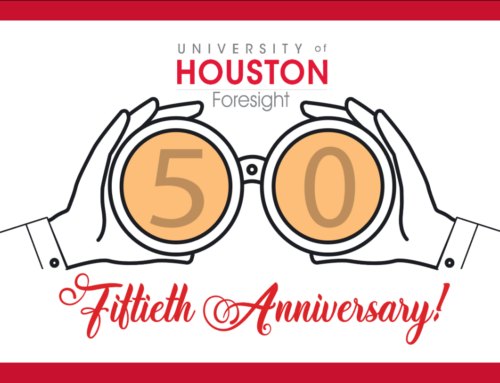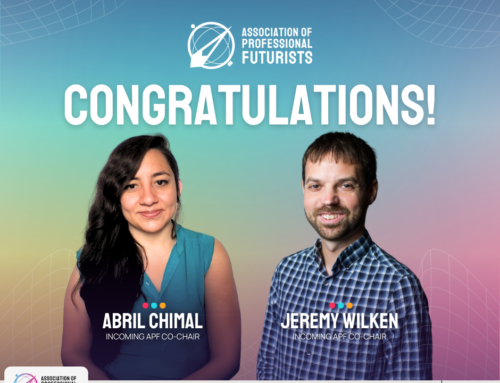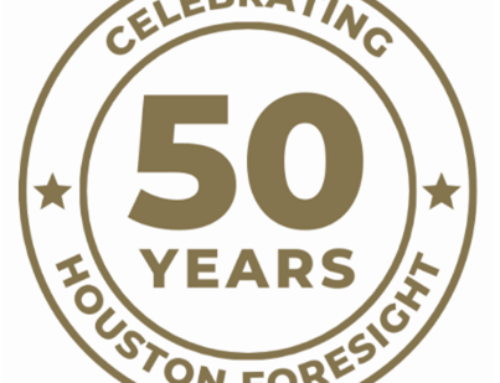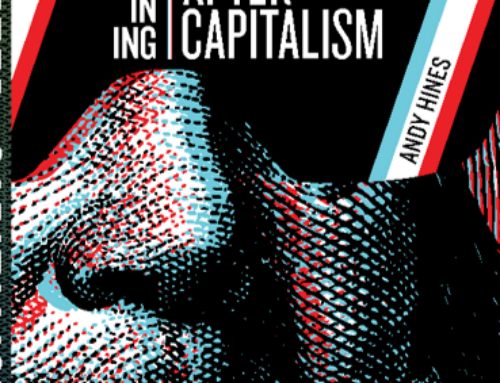The annual Houston Foresight Spring Gathering On April 17 and 18 was the perfect mix of fun, networking and learning — our brains hurt, but in a good way! (See flyer for overview and agenda for the weekend.) We started out Friday evening at Goode’s Taqueria for some food and margaritas and then band of hearty souls braved a torrential downpour and flash flooding to continue the party with some hookah at Byzantio.
The group reconvened Saturday to spend a day with alum John Smart. He spoke to us on “Technology Acceleration” and essentially provided a sneak preview of a summer elective he is teaching for us (also called “Technology Acceleration.” [See slides here])
A foundational concept of the day is John’s concept of “Evo Devo” -evolutionary development-. Indeed, Social Change students would recognize that we cover each separately — John has blended them together. While evolution presents unique options and choices, development is driven by predictable “intrinsic” trends, such as:
- Accelerating intelligence, Interdependence, and immunity (resilience) in global socio-technological systems
- Increased technological autonomy
- Increased intimacy of human-machine and physical digital interface
He observed that the future is an interplay of the Evo and Devo — of uncertainty and predictability. Those in the Houston Foresight program would recognize the “predictable/probable” piece as corresponding to the baseline and the uncertainty pieces corresponding to the alternatives.
John is a genuine polymath, referencing dozens of books throughout the day — it seemed there was not a topic that came up for which he could not supply a “go-to” reference and most of them can be found on his slides too [See slides here].
He sees infotech and nanotech as the key drivers of technology acceleration. He suggested that nanotech is the engine driving developments in infotech. They are able to grow at a much faster rate than biotech — noting the greater constraints on biological systems.
He has long been associated the Singularity, but he says it is probably further away than advocates suggest. Proponents often fail to anticipate social resistance that will slow it down. With AI, for instance, we discussed the example of developing “trained intelligence” with software/robotics which can be selected, much as we’ve done in domesticating animals over time.
suggest. Proponents often fail to anticipate social resistance that will slow it down. With AI, for instance, we discussed the example of developing “trained intelligence” with software/robotics which can be selected, much as we’ve done in domesticating animals over time.
The privacy issue came up, of course. He recommended Brin’sTransparent Society as a good book on the topic, in particular his notion of surveillance and sousveillance, that is, transparency will advance only if it comes from both the top down and the bottom up — from authorities and the public in a way that provides checks and balances.
We talked about digital twins and how our virtual persona lives on beyond our physical lives. We don’t yet have protocols to handle our legacy in the virtual world. We also talked about the TINA trends -There Is No Alternative-. Burris calls them the hard trends — those we can count on.
We also explored the possibilities of predictive analytics, which is going to enable us to see the holes between consumer demand and what we’re able to do.
Another interesting theme that emerged throughout the day was on “translating” foresight into “MBA language.” This is a key idea on his new Foresight Guide. He relates three core conceptsPhoto from John Smart of foresight this way:
- Possible futures = Innovation
- Probable futures = Forecasting
- Preferable futures = Strategy -how do we get there-
He talked a bunch about how important it is for futurist to know their own strengths, weaknesses, and preference. The point about how important it is for practitioners to “know thyself” was also a theme at dinner the night before. We have been covering that in Alternative Perspectives class — but perhaps we need more? John suggested that he has had good experiences leading weekend retreats or “fusions” to help with these and other practitioner-related issues. They consist of groups of a couple dozen get away for a weekend of discussion in a relaxing location.
An interesting innovation in the presentation style was having a second screen present, capably staffed by GA Maria Romero, to  highlight points John made throughout the day, such as books or websites. Definitely added some richness to the discussion and made note-taking a bit easier. Jim Breaux was kind enough to shoot some video and we’ll share from that what we can.
highlight points John made throughout the day, such as books or websites. Definitely added some richness to the discussion and made note-taking a bit easier. Jim Breaux was kind enough to shoot some video and we’ll share from that what we can.
He summed up the six key takeaways as:
- Accelerating change is real, and one key constraint on the future
- There are both evolutionary and developmental futures ahead
- We can tell better stories with diversity and constructive critique
- The foresight field is getting digital, and growing up fast
- Human-machine partnerships, teams, and entrep. will be key
- We are becoming informational entities, with indefinite lifespans
We weren’t done just yet. It was then off to the Hines pool for some food and fun. A little too chilly for the pool and the elements pushed us largely indoors, but that did not stop us from another enjoyable evening of conversations. The fifth annual Gathering was another smashing success!
Andy Hines









